Don’t Let Biases Towards Global Credit Overshadow the Opportunity
Executive Summary
While higher yielding segments of global credit markets can add alpha to diversified investment portfolios, these opportunities are often overlooked by Australian investors as the preference historically has skewed towards traditional asset classes. The most common pushback to investing in global credit markets that we hear is “credit spreads are too tight” or “the risk of default is too high.” By evaluating only spreads and defaults, we believe investors are overlooking sub-asset classes within credit offering higher yields and diversification. Ares focuses on what we view as the more senior, high-quality segments of the corporate debt and alternative credit markets; we call it the “sweet spot” of credit. This encompasses a $6.2 trillion opportunity set across U.S. and European loans, corporate bonds, and alternative credit markets1.
At the start of 2023, despite attractive credit spread and yield levels, recession fears and concerns around increased default risk stopped many market participants from investing in below investment grade credit. Fast forward through year-end and risk assets finished the year on strong footing, outperforming traditional fixed income.
In 2024, while dialogue around corporate default Armageddon has faded amid resilient growth data and progress on disinflation, credit spreads have tightened from last year’s wides. However, all-in yields remain attractive and we believe the combination of higher yields in floating rate loans alongside discounted prices in high yield bonds offers alpha-generating opportunities for active managers, such as Ares.
Alpha in the Sweet Spot of Credit
Ares seeks to find the most attractive relative value opportunities in the “sweet spot” of credit to deliver higher yielding investment solutions with optimal downside protection and lower volatility. As illustrated in Figure 1, asset classes in scope achieved similar returns to traditional growth assets, such as equities, with half the price volatility over the 15-year period ending March 31, 2024.
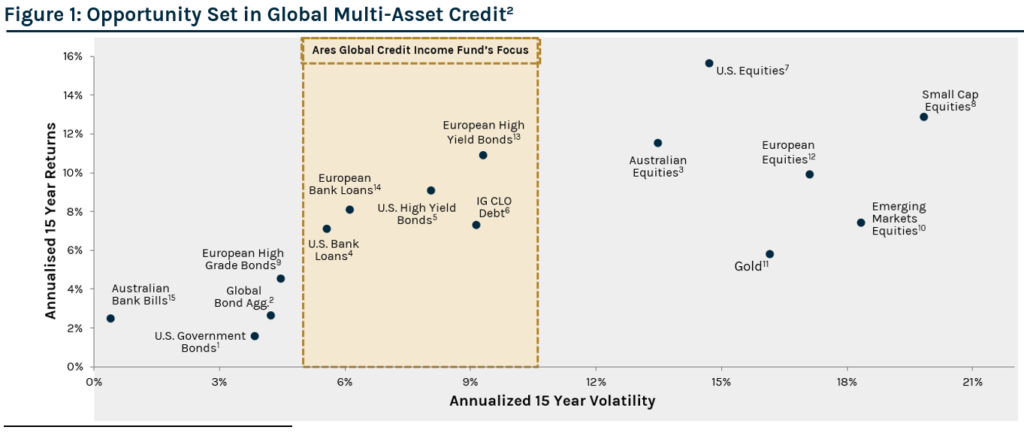
As illustrated by the charts in Figure 2, we believe higher yielding, low duration assets that have complementary qualities can be accessed to efficiently manage exposures throughout cycles, while building a portfolio that provides diversification and yield premium relative to traditional fixed income. While traditional investment solutions have long been viewed as a safe haven for equity price volatility, in today’s new rate regime, low credit risk no longer goes hand-in-hand with low mark-to-market volatility. As we view the main risks underpinning below-investment grade credit to be credit risk and price volatility (not duration or liquidity risk), we believe investors are rewarded for being both disciplined credit selectors and tactical asset allocators.
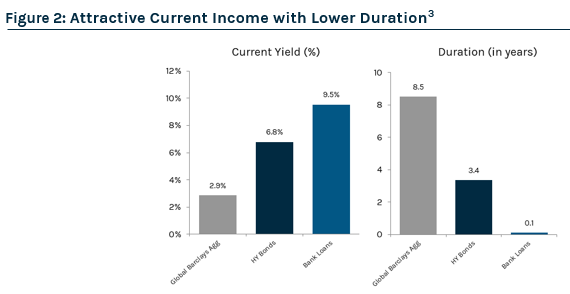
By investing in the opportunity set outlined above, Ares seeks to construct high quality, income generating portfolios that provide a buffer against choppy price movements and minimize default risk through discerning credit selection and vigilant risk management.
2023 – A Great Year for Floating Rate Senior Secured Credit
At the start of 2023, we viewed the entry point in leveraged credit to be attractive given the high levels of current yield and potential for spread tightening, particularly in floating rate loans. As shifts in relative value occurred, we capitalized on several opportunities throughout the year to generate alpha within our multi-asset credit portfolios through active asset rotation and disciplined credit selection. We maintained our lower risk and duration posture during the first half of the year given tighter monetary policy and concerns around slowing global growth. After months of de-risking, we moved towards a more neutral risk posture as risk assets stabilized amid better-than-expected corporate earnings and easing banking crisis fears. In the third quarter, we marginally increased fixed rate exposure with the goal of adding convexity to our portfolios as we neared what we believed was the end of the hiking cycle. Importantly, high yield bonds, bank loans, and CLO debt finished the year in a strong position, benefitting from positive macro news and a stronger bid for risk assets in the fourth quarter. As illustrated in Figure 3, performance of our preferred asset classes outperformed traditional fixed income in 2023.
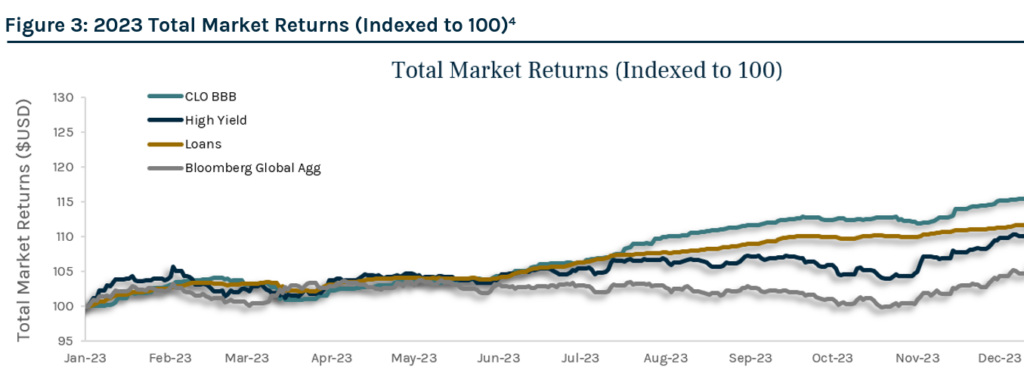
Early in 2023, we were focused on managing a few key tail risks including increased ratings downgrades and heightened volatility given our expectation for slower growth. Although we anticipated high yield bond and bank loan defaults to rise off the lows seen in 2022, we had expected defaults to remain manageable and in line with historical averages. Our default outlook at that time was supported by stable corporate fundamentals due in part to the recent cycle and better issuer balance sheets and liquidity. As many issuers refinanced at attractive levels in 2020 and 2021, most were able to push out near-term maturities and shore up liquidity heading into 2023. Fast forward through today, we saw a modest pick-up in default rates during the last twelve months; however, they remained in the 1-3% context. Specifically, the twelve-month trailing par-weighted U.S. high yield bond and loan default rates have increased to 1.0% and 2.4% as of March 31, 2024, respectively.
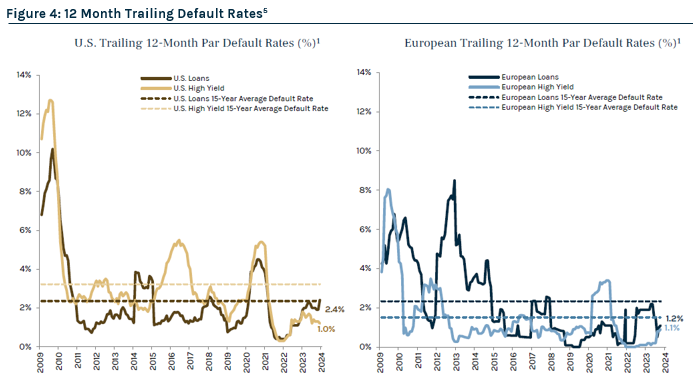
Ares seeks to employ superior credit selection through our disciplined investment process that focuses on capital preservation, predicated on bottom-up fundamental research with the goal of minimizing default risk by identifying and avoiding marginal quality credit. This core tenet of Ares’ investment philosophy has resulted in significantly lower defaults relative to the broader market in Ares’ high yield bond and bank loan strategies6.
2024 Outlook
Against this backdrop of tighter credit spreads, several market commentators have dismissed leveraged credit yet again. We would counter that sentiment by asking (1) what part of the credit market do you consider when making that statement? and (2) shouldn’t other factors such as credit quality, convexity and yield be considered?
We believe an investor should not only look at spreads when evaluating credit markets and would argue there is a compelling case to be made for certain asset categories within corporate debt and alternative credit markets, which offer potential for 1) strong income from loans, 2) discount opportunity in high yield bonds, and 3) yield pickup and credit enhancement from CLOs.
With attractive cash yields in the high single digits, loans continue to provide an attractive forward return opportunity. Notably, current yield levels for U.S. and European loans are greater than 89% and 80% of historical levels for the post-Global Financial Crisis period, respectively7. In our multi-asset credit strategies, loans are the core allocation to anchor returns in high levels of current income.
While bond spreads are screening tight, we believe the bond market at current discounted levels is presenting an attractive entry point and alpha-generating opportunity, particularly in the lower rated segment of the market where we’ve seen growing bifurcation. As illustrated in Figure 5, today’s average price of U.S. and European high yield bonds is $91.9 and $92.9, respectively. While we expect income to continue to be the main driver of returns in 2024, it’s worth noting the potential for capital appreciation in bonds – assuming the bond does not default, a bond’s price will benefit from a natural “pull to par” and early take-outs where the bond is repaid at nominal value ahead of maturity. Lastly, we believe CLOs continue to offer attractive relative value compared to loan-only portfolios, similarly rated securitized products and corporate debt given the significant yield pickup. We believe both opportunities in bonds and CLOs are a great complement to our core allocation to loans in our multi-asset credit strategies.
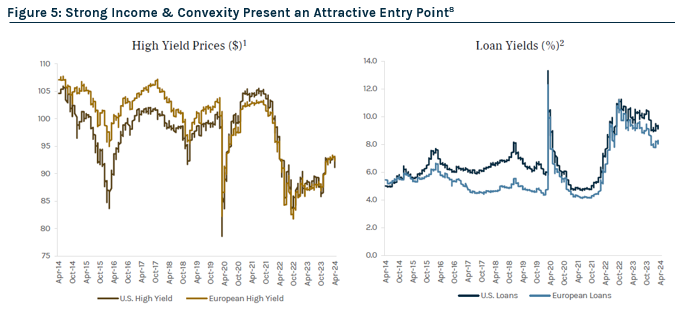
Looking forward, we expect attractive loan and high yield returns over the next 12 months given the starting point from a yield and discount perspective.
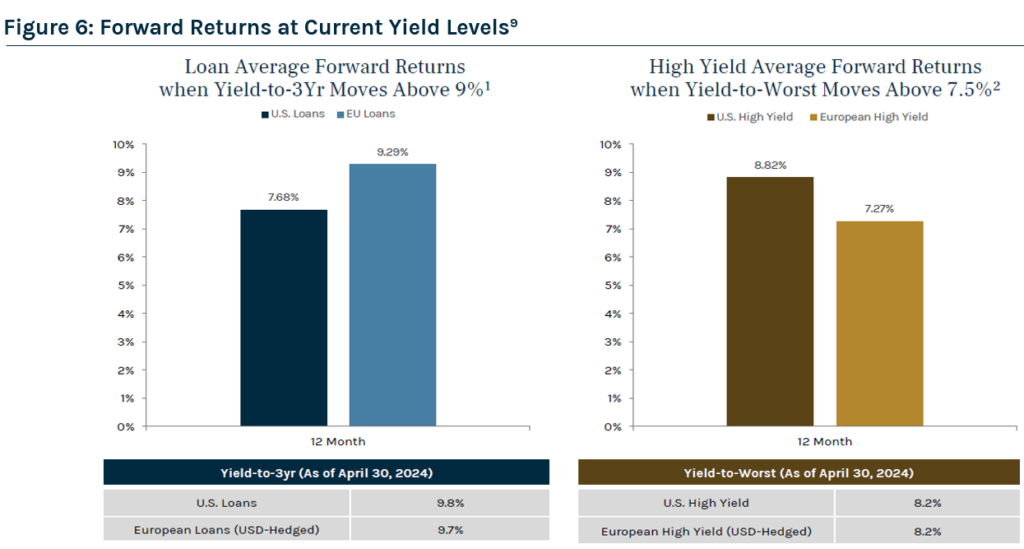
Conclusion
Credit spreads and default rates are important metrics to consider when evaluating credit markets; however, taking a single number into account to qualify such a diverse market is likely to lead to missed opportunities. We believe Ares is well-positioned to capture the most attractive relative value opportunities in the “sweet spot” of credit as we seek to deliver enhanced yield with optimal downside protection and lower volatility. Our differentiated approach to capitalizing on the best risk-adjusted return opportunities across the investable universe is rooted in the scale and integration of our Global Liquid and Alternative Credit strategies, which allows us to fully leverage extensive research and origination capabilities, proprietary technologies and longstanding relationships across the platform.
In closing, in today’s “higher for longer” interest rate environment, we believe flexible investment solutions anchored in higher yielding segments of the corporate and alternative credit markets are poised to benefit from the attractive forward return potential while fundamentals remain stable, and the technical backdrop remains supportive.
[1] Source: Global Credit Suisse Leveraged Loan Index, ICE BofA Global High Yield Index, J.P. Morgan CMBS Research, J.P. Morgan ABS Research: ABS Volume Datasheet Report, Ares INsight database, Intex. As of March 31, 2024. Assumes a 1.08 EUR/USD exchange rate where applicable.
[2] Note: As of March 31, 2024. Please see endnotes for Index Definitions and an important index disclosure. For illustrative purposes only. (1) ICE BofA Current 5-Year US Treasury Index. (2) Bloomberg Barclays Global Aggregate Bond Index. (3) S&P/ASX 200. (4) Credit Suisse Leveraged Loan Index. (5) ICE BofA US High Yield Index. (6) JPM U.S. CLOIE BBB Post-Global Financial Crisis Index. (7) S&P 500.(8) Russell 2000. (9) ICE BofA Euro Corporate Index. (10) Dow Jones Emerging Markets Index. (11) IAU ETF. (12) EURO STOXX 50. (13) ICE BofA Euro High Yield Index. (14) Credit Suisse Western European Leveraged Loan Index. (15) Bloomberg AusBond Bank Bill Index
[3] As of April 30, 2024. Source: BofA, Bloomberg, Credit Suisse. Assumes a 1.08 EUR/USD exchange rate, where applicable. Please see endnotes for Index Definitions.
[4] Note: As of December 31, 2023. Index data is provided for comparison purposes only. Projections and forward looking statements are not reliable indicators of future events and no guarantee or assurance is given that such activities will occur as expected or at all. Sources: ICE BofA US High Yield Index, Credit Suisse Leveraged Loan Index, Bloomberg’s Global Aggregate Index USD-hedged, CLOIE BBB, and CLOIE BB. Please see endnotes for Index Definitions.
[5] For illustrative purposes only. All data as of March 31, 2024 unless otherwise stated. For illustrative purposes only. Please see endnotes for index definitions. (1) Source: Credit Suisse, as of March 31, 2024. European Loans represented by the Credit Suisse Western European Leveraged Loan Index. U.S. Loans represented by the Credit Suisse Leveraged Loan Index. European High Yield represented by the Credit Suisse Western European High Yield Index. U.S High Yield represented by the Credit Suisse U.S. High Yield Index. Distressed exchanges included in default rate calculation.
[6] Average annual default rate of 0.97% and 0.75% in Ares high yield and bank loan track records vs. 3.61% and 2.32% for U.S. high yield and bank loans, respectively. Represents the LTM annual average par weighted default rates for the period January 1, 2009 December 31, 2023. Bank loan default rates represented by the Credit Suisse Leveraged Loan Index. High yield default rates are represented by the Bank of America High Yield “H0A0”. Ares default rates for loans and high yield bonds are represented by all bank loan and bond transactions in all commingled funds and separately managed accounts executed by investment professionals within Ares Liquid Credit Group.
[7] Source: Credit Source. Reflects yields for CSLLI and WELLI. As of April 30, 2024.
[8] For illustrative purposes only. As of April 30, 2024. Sources: HUC0, HPC0, CSLLI and CSWELLI. Please see endnotes for index definitions.
[9] For illustrative purposes only. Source: Credit Suisse, ICE BofA Indices, Bloomberg. All yields and forward returns are USD-hedged. The period of analysis is from January 1997 to April 2024. The chart shows the forward returns of asset classes when respective yields exceed 9% for high yield and 11% for loans as defined by yield-to-worst for high yield bonds and yield to 3-year life for bank loans. Data as of April 30, 2024. U.S. Bank Loans represented by the CSLLI and European bank loans represented by the CSWELLI. US. high yield represented by the HUC0 and European high yield represented by the HPSD. Please see endnotes for index definitions.
Index Disclosure & Definitions
Index Disclosure: Indices are provided for illustrative purposes only and not indicative of any investment. They have not been selected to represent appropriate benchmarks or targets for the strategy. Rather, the indices shown are provided solely to illustrate the performance of well-known and widely recognized indices. Any comparisons herein of the investment performance of a strategy to an index are qualified as follows: (i) the volatility of such index will likely be materially different from that of the strategy; (ii) such index will, in many cases, employ different investment guidelines and criteria than the strategy and, therefore, holdings in such strategy will differ significantly from holdings of the securities that comprise such index and such strategy may invest in different asset classes altogether from the illustrative index, which may materially impact the performance of the strategy relative to the index; and (iii) the performance of such index is disclosed solely to allow for comparison on the referenced strategy’s performance to that of a well-known index. Comparisons to indices have limitations because indices have risk profiles, volatility, asset composition and other material characteristics that will differ from the strategy. The indices do not reflect the deduction of fees or expenses. You cannot invest directly in an index. No representation is being made as to the risk profile of any benchmark or index relative to the risk profile of the strategy presented herein. There can be no assurance that the future performance of any specific investment, investment strategy, or product will be profitable, equal any corresponding indicated historical performance or be suitable for a portfolio. The information related to the various indices is sourced from the providers’ websites. Ares is not responsible for any historic revision made to the indices.
The Bloomberg Barclays Capital Global Aggregate Bond Index (“Barclays Global Agg”) measures the performance of global investment grade debt from twenty-four local currency markets. This multi-currency benchmark includes treasury, government-related, corporate and securitized fixed-rate bonds from both developed and emerging market issuers. To be included in the index, bonds must be investment grade using the index credit quality classification methodology (middle rating of Moody’s, Fitch and S&P). The currency must be freely tradeable and convertible and not exposed to exchange controls that are designed to encumber its buying and selling by foreign investors. There must be an established and developed forward market or non-deliverable forward (NDF) market for the local currency such that foreign market participants can hedge their exposures into core currencies. Inception date: January 1, 1990.
The Credit Suisse Western European Leveraged Loan Index (“CSWELLI”) is designed to mirror the investable universe of the leveraged loan market of issues which are denominated in US$ or Western European currencies. The issuer has assets located in or revenues derived from Western Europe, or the loan represents assets in Western Europe, such as a loan denominated in a Western European currency. Loan facilities must be rated “5B” or lower. That is, the highest Moody’s/S&P ratings are Baa1/BB+ or Ba1/BBB+. Only fully funded term loan facilities are included and the tenor must be at least one year. Minimum outstanding balance is $100 million and new loans must be priced by a third-party vendor at month-end. The index inception is January 1998.
The Credit Suisse Institutional Leveraged Loan Index (“CSLLI”) is designed to mirror the investable universe of the $US-denominated leveraged loan market. The index inception is January 1992. The index is priced daily and rebalanced monthly. New loans are added to the index on their effective date if they qualify according to the following criteria: 1) Loan facilities must be rated “5B” or lower. That is, the highest Moody’s/S&P ratings are Baa1/BB+ or Ba1/BBB+. If unrated, the initial spread level must be Libor plus 125 basis points or higher. 2) Only fully-funded term loan facilities are included. 3) The tenor must be at least one year. 4) Issuers must be domiciled in developed countries; issuers from developing countries are excluded.
ICE BofA European Currency High Yield Index (“HPC0”) tracks the performance of EUR and GBP denominated below investment grade corporate debt publicly issued in the eurobond, sterling domestic or euro domestic markets. Qualifying securities must have a below investment grade rating (based on an average of Moody’s, S&P and Fitch) and an investment grade rated country of risk (based on an average of Moody’s, S&P and Fitch foreign currency long term sovereign debt ratings). In addition, qualifying securities must have at least one year remaining term to final maturity, a fixed coupon schedule and a minimum amount outstanding of EUR 100 million or GBP 50 million. Original issue zero coupon bonds, “global” securities (debt issued simultaneously in the eurobond and domestic markets), 144a securities and pay-in-kind securities, including toggle notes, qualify for inclusion in the Index. Callable perpetual securities qualify provided they are at least one year from the first call date. Fixed-to-floating rate securities also qualify provided they are callable within the fixed rate period and are at least one year from the last call prior to the date the bond transitions from a fixed to a floating rate security. Defaulted, warrant-bearing and euro legacy currency securities are excluded from the Index. Inception date: December 31, 1997 The above rules take into account all revisions up to and including December 31, 2010.
The BofA US High Yield Master II Constrained Index (“HUC0”) tracks the performance of US Dollar denominated below investment grade corporate debt publicly issued in the US domestic market with a maximum issuer exposure of 2%. The index is priced daily and rebalanced monthly. The returns of the benchmark are provided to represent the investment environment existing during the time period shown. For comparison purposes the index includes the reinvestment of income and other earnings but does not include any transaction costs, management fees or other costs. ICE BANK OF AMERICA IS LICENSING THE ICE BofA INDICES AND RELATED DATA “AS IS,” MAKES NO WARRANTIES REGARDING SAME, DOES NOT GUARANTEE THE SUITABILITY, QUALITY, ACCURACY, TIMELINESS, AND/OR COMPLETENESS OF THE ICE BofA INDICES OR ANY DATA INCLUDED IN, RELATED TO, OR DERIVED THEREFROM, ASSUMES NO LIABILITY IN CONNECTION WITH THEIR USE, AND DOES NOT SPONSOR, ENDORSE, OR RECOMMEND ARES MANAGEMENT, OR ANY OF ITS PRODUCTS OR SERVICES.
The S&P 500 is an American stock market index based on the market capitalisations of 500 large companies having common stock listed on the NYSE or NASDAQ. The S&P 500 index components and their weightings are determined by S&P Dow Jones Indices
Disclaimer
This material has been prepared by Ares Australia Management Pty Ltd (ABN 51 636 490 732 AFSL 537 666) (AAM), the investment manager of the Ares Diversified Credit Fund (ARSN is 639 123 112) (ADCF) and Ares Global Credit Income Fund (ARSN 639 123 112) (AGCIF). Fidante Partners Limited (ABN 94 002 835 592 AFSL 234668) (Fidante) is a member of the Challenger Limited group of companies (Challenger Group) and the responsible entity of ADCF and AGCIF. Other than information which is sourced from Fidante in relation to ADCF and AGCIF, Fidante is not responsible for the information in this publication, including any statements of opinion. It is general information only and is not intended to provide you with financial advice or take into account your objectives, financial situation or needs. Investors should consider whether the information is suitable to their circumstances. To the extent permitted by law, no liability is accepted for any loss or damage as a result of reliance on this information. AAM is authorised to provide financial services to ‘wholesale clients’ only (within the meaning of the Corporations Act 2001 (Cth)) in Australia. The information in this publication has been provided by AAM on this basis and is for use by such wholesale clients only and no other persons. The Information Memorandum for ADCF and Product Disclosure Statement for AGCIF (together, the “governing documents”), issued by Fidante, should be considered before deciding whether to acquire or hold units in ADCF or interests in AGCIF. The governing documents can be obtained from the Fidante Partners’ Investor Services team on 13 51 53 or website www.fidante.com.au. Past performance is not indicative of future performance. Any projections are based on assumptions which we believe are reasonable but are subject to change and should not be relied upon. Fidante is not an authorised deposit-taking institution (ADI) for the purpose of the Banking Act 1959 (Cth), and its obligations do not represent deposits or liabilities of an ADI in the Challenger Group (Challenger ADI) and no Challenger ADI provides a guarantee or otherwise provides assurance in respect of the obligations of Fidante. Investments in ADCF and AGCIF are subject to investment risk, including possible delays in repayment and loss of income or principal invested. The performance, the repayment of capital or any particular rate of return on your investments are not guaranteed by any member of the Challenger Group nor AAM or its related bodies corporate.
No reliance: This publication is provided to you on the basis that it should not be relied upon for any purpose other than information and discussion. The publication has not been independently verified. None of Ares, Fidante Partners Limited, Ares Australia Management Pty Ltd, nor any of their respective related bodies corporates, associates and employees, make any republications, warranty or undertaking (express or implied) and accepts no responsibility for the adequacy, accuracy, completeness or reasonableness of the publication or as to the performance of any product. The information contained in the publication does not purport to be complete and is subject to change. No reliance may be placed for any purpose on the publication or its accuracy, fairness, correctness or completeness. None of Ares, Fidante Partners Limited, Ares Australia Management Pty Ltd, nor any of their respective related bodies corporates, associates and employees shall have any liability whatsoever (in negligence or otherwise) for any loss howsoever arising from any use of the publication or otherwise in connection with the publication. Any forward-looking statements in this publication: are made as of the date of such statements; are not guarantees of future performance; and are subject to numerous assumptions, risks and uncertainties because they relate to events and depend on circumstances that may or may not occur in the future. Ares undertakes no obligation to update such statements. Past performance is not a reliable indicator of future performance.
Confidentiality and intellectual property: This publication is confidential and may not be copied, reproduced or redistributed, directly or indirectly, in whole or in part, to any other person in any manner.
Risk: no person guarantees the performance of, or rate of return from, any product or strategy relating to this publication, nor the repayment of capital in relation to an investment in such product or strategy. An investment in any such product or strategy is not a deposit with, nor another liability of, Ares, Fidante Partners Limited, Ares Australia Management Pty Ltd nor any of their respective related bodies corporates, associates or employees. Investment in any product or strategy relating to this publication is subject to investment risks, including possible delays in repayment and loss of income and capital invested.
REF: AAM-00516
Related Insights
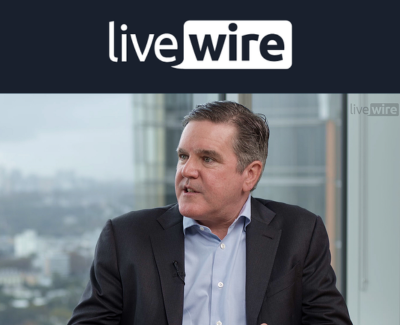
Livewire: One way to navigate trade-induced volatility is to avoid it altogether

Livewire: Real estate values have bottomed and the market recovery is on
